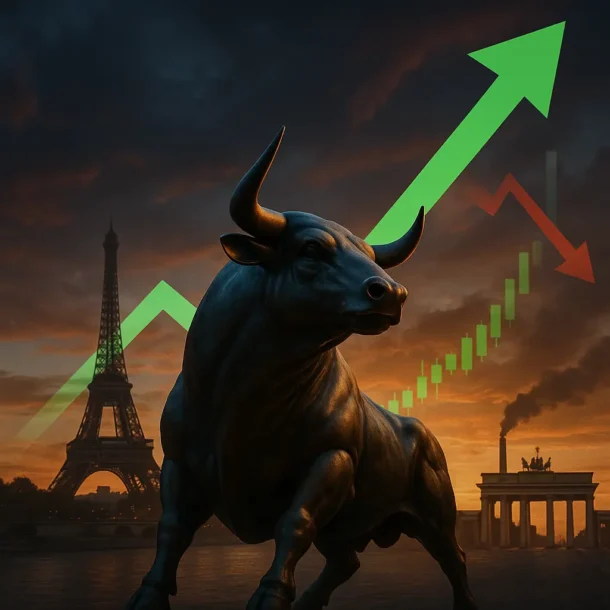Introduction
The stock market is often perceived as a barometer of economic health, reflecting investor sentiment and economic trends. However, it’s also known for its volatility, with market crashes being a frequent, albeit unwelcome, event in the financial world. This article delves into the intricacies of stock market crashes, backed by historical data and analysis, to provide a comprehensive understanding of their causes, impacts, and strategies for navigating them.
For those who want to get started in investing, consider using our affiliate link for Trade Republic. By using this link, you’ll receive a €30 bonus (if you complete 3 purchase transactions in 10 days) in shares as a gift: Trade Republic.
Alternatively, you can simply follow our ideas or take up our positions. You will also receive reports, analyses, and alerts by email via the following link: Subscription.
For those who prefer to select individual stocks for the medium to long term, it is crucial to first understand what type of investor you are. To help with this, we have created three articles summarizing the three main types of investors: Value Investors, Growth Investors, and GARP Investors. Additionally, for those interested in passive investment strategies over a very long term (20-30 years), our guide on building a robust ETF portfolio offers comprehensive insights. Furthermore, you can learn more about investing in commodities. Also, check out our article on swing trading, which is an excellent strategy for both individual investors and professional fund managers.
In addition, we invite you to explore our latest article on how to invest in cryptocurrency. This comprehensive guide covers everything you need to know to navigate the exciting world of digital assets. If you want to learn how to unearth cryptocurrencies yourself, we recommend the following book , which details the best decision-making process for cryptographic protocols.
Lastly, you can access our other parabolic growth strategy called biotech strategy. Additionally, you can access our article on the special strategy called Dividend Capture Strategy.
Historical Context of Market Crashes
Stock market crashes have been an integral part of the financial landscape since the inception of modern markets. Since 1900, the U.S. stock market, represented by the S&P 500, has experienced 36 crashes, each defined by a drop of at least 20% from its peak . On average, this translates to a crash approximately every 3.5 to 4 years, making them a relatively common occurrence.
For instance, the S&P 500 index saw a dramatic fall during the Great Depression, beginning in 1929, with a decline of nearly 86% over a span of three years. Similarly, the 2000 dot-com bubble burst led to a 49% decline, while the 2008 financial crisis wiped out 57% of the index’s value .
More recently, the COVID-19 pandemic triggered a sharp sell-off in March 2020, with the S&P 500 plummeting by over 30% in just a few weeks. However, this crash was followed by an equally swift recovery, demonstrating the market’s resilience and the importance of long-term investing .
Causes of Stock Market Crashes
While each crash has its unique catalysts, several common factors often contribute to these market downturns:
- Economic Slowdowns: Recessions or significant economic slowdowns often precede market crashes. For example, the 2008 financial crisis was triggered by the collapse of the housing market, leading to a global economic downturn .
- Market Bubbles: When asset prices rise significantly above their intrinsic value, a bubble is formed. The bursting of these bubbles, such as the dot-com bubble in 2000 or the housing bubble in 2008, often leads to a crash .
- Interest Rate Hikes: Rising interest rates can reduce corporate profits and consumer spending, leading to lower stock prices. The U.S. Federal Reserve’s tightening of monetary policy in the late 1990s and early 2000s contributed to the dot-com crash .
- Geopolitical Events: Wars, political instability, and other geopolitical events can trigger fear and uncertainty, leading to market sell-offs. The 1973 oil crisis, for example, caused a significant market downturn .
- Investor Psychology: Market sentiment plays a crucial role in crashes. The “Fear of Missing Out” (FOMO) often drives prices up during bull markets, while panic selling can exacerbate declines during bear markets .
The Impact of Market Crashes
The immediate impact of a stock market crash is a significant loss of wealth for investors. However, the long-term effects can be more profound, influencing economic conditions, investor behavior, and regulatory policies.
Economic Recession: Stock market crashes often lead to or coincide with economic recessions. The 1929 crash, for example, triggered the Great Depression, which saw global GDP decline by 15% . Similarly, the 2008 crash led to the Great Recession, with global economic output shrinking by 0.1% in 2009 .
Unemployment: Market crashes and subsequent recessions often lead to higher unemployment rates. During the Great Depression, U.S. unemployment peaked at 24.9%, while the 2008 financial crisis saw unemployment rise to 10% in the U.S. .
Regulatory Changes: Crashes often lead to changes in financial regulations to prevent future crises. The 1929 crash resulted in the establishment of the U.S. Securities and Exchange Commission (SEC) in 1934, while the 2008 crisis led to the Dodd-Frank Wall Street Reform and Consumer Protection Act in 2010 .
Strategies for Navigating Market Crashes
While market crashes can be daunting, there are strategies that investors can employ to mitigate risks and capitalize on opportunities during downturns.
- Diversification: By spreading investments across different asset classes, sectors, and geographies, investors can reduce their exposure to any single market downturn. For example, while the S&P 500 fell 36% on average during crashes, bonds and other assets often perform better during these periods .
- Dollar-Cost Averaging: This strategy involves investing a fixed amount of money at regular intervals, regardless of market conditions. This approach can reduce the impact of volatility and lower the average cost per share during market downturns .
- Maintaining a Cash Reserve: Having a cash reserve allows investors to take advantage of buying opportunities during market downturns without having to sell other investments at a loss. A cash reserve also provides a financial cushion during economic uncertainties .
- Staying Invested: History shows that markets tend to recover over time. For instance, the S&P 500 has always rebounded from previous crashes, with the average recovery time being 10 months . By staying invested, investors can benefit from eventual market recoveries.
- Rebalancing Portfolios: During market crashes, certain asset classes may perform better than others. Regularly rebalancing portfolios can help maintain the desired risk level and take advantage of shifts in market conditions .
Case Study: The 2008 Financial Crisis
The 2008 financial crisis serves as a critical example of the impact of a stock market crash and the subsequent recovery. Triggered by the collapse of the housing bubble and the failure of financial institutions, the S&P 500 fell by 57% from its peak in October 2007 to its trough in March 2009 .
The crisis led to a global economic recession, with worldwide GDP shrinking by 0.1% in 2009 . Unemployment rates soared, with U.S. unemployment reaching 10% in October 2009. In response, central banks around the world implemented unprecedented monetary policies, including near-zero interest rates and large-scale asset purchases, to stabilize the economy .
Despite the severity of the crash, markets eventually recovered. The S&P 500 began a decade-long bull run, gaining over 400% from its 2009 low by the end of 2019 . This recovery highlights the resilience of financial markets and the importance of a long-term investment perspective.
The Future of Market Crashes
While it’s impossible to predict the timing or magnitude of the next market crash, several indicators suggest that markets may be overdue for a correction. As of 2024, major indices like the S&P 500 and Nasdaq 100 have seen tremendous growth since the 2009 financial crisis, with gains of 771% and 1400%, respectively .
However, these gains have also led to stretched valuations, with some companies reaching unprecedented market capitalizations. For example, Microsoft and Nvidia have market capitalizations exceeding $3 trillion and $2 trillion, respectively, surpassing the combined value of entire indices like the FTSE 100 and DAX .
The fear of missing out (FOMO) has driven many investors into the market, often without a full understanding of the risks involved. This has contributed to elevated market sentiment, as reflected in the CNN Fear & Greed Index, which has reached levels of “extreme greed” .
In recent developments, according to data from Bloomberg as cited by Apollo’s Chief Economist, 41% of companies within the Russell 2000 index are now reporting negative earnings. This figure has more than doubled since 2006 and is comparable to the levels observed during the peak of the 2008 Financial Crisis. This alarming trend highlights the growing financial stress among small-cap companies and serves as a stark reminder of the market’s fragility. It underscores the importance of being vigilant and prepared for potential downturns, especially as the current economic conditions bear troubling similarities to past crises.
Additionally, the Buffett Indicator, which compares the total market capitalization to GDP, is flashing warning signs. As of 2024, the Buffett Indicator stands at approximately 173%, significantly above the threshold of 100% that Warren Buffett considers indicative of an overvalued market. Historically, a ratio above 120% has often preceded major market corrections, such as those seen during the dot-com bubble burst in 2000 and the 2008 financial crisis. This suggests that the market is currently highly overvalued, reinforcing the notion that a market correction or downturn may be on the horizon, further emphasizing the need for a cautious and well-prepared investment strategy.
Investors can leverage GuruFocus to delve deeper into these financial metrics and identify value opportunities.
Conclusion
Stock market crashes are an inevitable part of investing. While they can be unsettling, understanding their causes, impacts, and the strategies for navigating them can help investors weather these storms. By maintaining a diversified portfolio, staying invested, and focusing on long-term goals, investors can not only survive but potentially thrive during market downturns.
As history has shown, markets have always recovered from past crashes, often reaching new highs. Therefore, while the fear of a market crash is real, it should not deter long-term investors from participating in the market. Instead, by being prepared and adopting a disciplined approach, investors can navigate the volatility and emerge stronger on the other side.
For more insights into analyzing value and growth stocks poised for sustainable growth, consider this expert guide. It provides valuable strategies for identifying high-potential value and growth stocks.
We also have other highly attractive stocks, commodities and crypto in our portfolios. To explore these opportunities, visit our investment portfolios.
This analysis is informational only and should not be construed as investment advice. Always conduct your own research or consult with a financial advisor before making investment decisions.
References
- S&P 500 Historical Data – Yahoo Finance
- The Great Depression: An Overview – Investopedia
- Dot-Com Bubble Burst – The Balance
- 2008 Financial Crisis – Federal Reserve History
- COVID-19 Market Crash – Bloomberg
- Market Crashes: Causes, Consequences, and Lessons – CFA Institute
- The Impact of Market Bubbles – Forbes
- Fear & Greed Index – CNN Business
- Microsoft and Nvidia Market Capitalization – MarketWatch









0 Comments